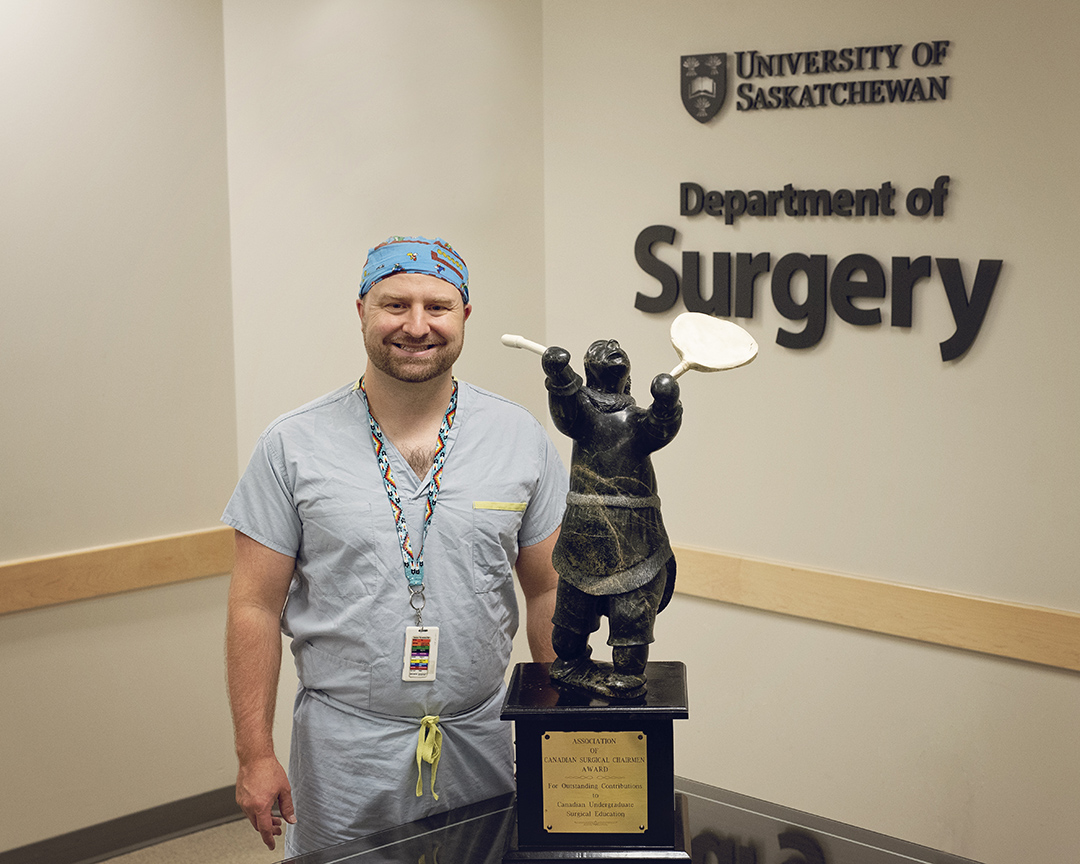
USask surgeon nationally recognized for educational excellence
University of Saskatchewan (USask) surgeon Dr. Trustin Domes (MD, MEd) has been awarded the John Provan Outstanding Surgical Educator Award.
By Kristen McEwenThis national award is presented every two years by the Canadian Undergraduate Surgical Education Committee and Canadian Surgical Chairs to recognize a recipient’s “outstanding contribution to undergraduate surgical education in Canada.”
“I’m truly honoured and humbled to have received this award,” Domes said. “I’m passionate about education and have been fortunate to have the support of my colleagues, the Department of Surgery and the College of Medicine to be able to incorporate education as a major part of my surgical career.”
“Being recognized by my peers for what I enjoy doing is great, but making an impactful difference for my learners, and the systems in which they learn, brings me the most joy,” he added.
Domes is an assistant professor of urology in the Department of Surgery and the admissions director for the MD program in the College of Medicine. He is the first-ever recipient from USask to be presented with the award.
Domes has worked within the College of Medicine since 2011. He has been the director of undergraduate surgical education for the Department of Surgery since 2015, being heavily involved with restructuring the undergraduate surgical curriculum and helping to create an environment that improved faculty engagement with surgical teaching. The surgery department has a large teaching footprint with 230 faculty province-wide providing thousands of pre-clerkship and clerkship teaching hours per year.
A series of nomination letters from colleagues and learners outlined Domes’ contributions to surgical education and the impact he’s had on learners’ education.
Learners have consistently ranked Domes as a “superb teacher.” He is known for creating positive learning environments and supporting students in their learning journey, as well as encouraging surgeon colleagues to be involved in teaching.
“Learning is a two-way street and as educators, we also have a lot to learn from our learners too!” Domes said. “It is important to interact with our medical learners like they are our junior colleagues and have the perspective that our ‘teaching’ is actually providing coaching and guidance so our learners can be successful along their educational journey.”
As an educator, Domes looks to create a positive learning environment through three main goals:
- Breaking the myth that surgeons, operating rooms and the learning environment in surgery is intimidating and scary
- Creating learning opportunities that are experiential, impactful, useful and genuine
- Being a learner ally by listening and collaborating with learners to make things better
He is also known as an educational innovator and was instrumental in implementing a series of surgical webinars produced by USask surgeons that have been viewed hundreds of times by students in surgical clerkship. Domes was played a crucial role in developing a smartphone app to evaluate clerkship students completing their entrustable professional activities (EPAs).
This app was first piloted in surgery and is now used to capture all 12 EPAs for third and fourth year USask MD program students. He also was the first faculty member in the College of Medicine to pilot and implement team-based learning into the undergraduate curriculum.
On the national level, Domes has been involved in designing Competency by Design Frameworks with the Royal College of Physicians and Surgeons in Surgical Foundations. He is the current Chair of the Royal College Urology Examination Committee and the Canadian Undergraduate Urology Education Committee through the Canadian Urological Association.
“My favourite part of teaching is actually seeing the transformation of the learner occurring right before my eyes,” Domes said. “At the micro-level, this could be witnessing a learner perfectly suturing a wound after spending hours practicing the technique. At the macro-level, it is remembering how far individuals have come from the very start of their medical education journey to interacting with them as present day competent and caring practicing physicians.
“As an educator, I hope my teaching and influence positively impacted them and their practice in some way.”
